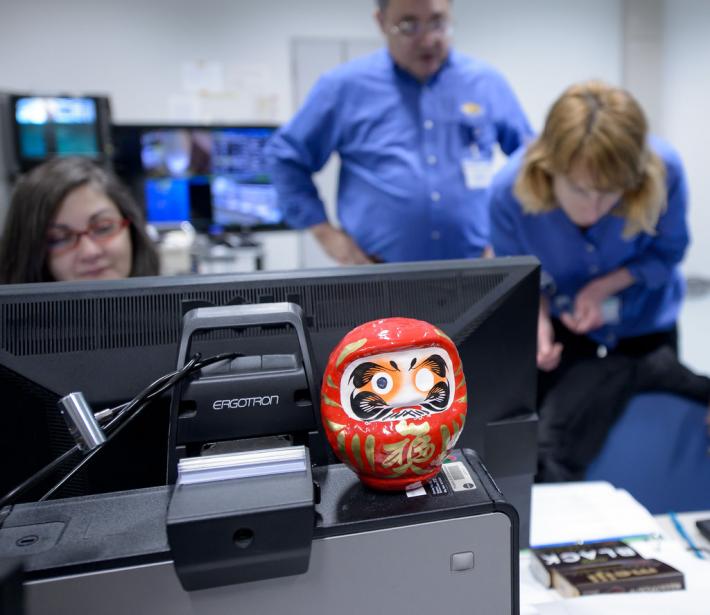
GPM's Rehearsal Weekend at Tanegashima
Image Credit: NASA's Goddard Space Flight Center/Michael Starobin
Download this video in HD formats from the Scientific Visualization Studio
On the first floor of the Spacecraft Test and Assembly building at the Japan Aerospace Exploration Agency's Tanegashima Space Center, Japan, a skeleton crew of blue-shirted NASA engineers for the Global Precipitation Measurement (GPM) mission fill three rows of computer stations. Sitting with them, on top of one of the desktop computers, is a squat, roundish doll. About the size of a grapefruit, it’s bright red with a stylized, decorative face. Its most noticeable feature is that it only has one eye colored in.
"It's a Daruma doll," systems engineer Lisa Bartusek of NASA said during a lull in the launch dress rehearsal that took place Feb. 22 and 23, the weekend before the GPM launch. The doll is a symbol of good luck and in Japan is often given as a gift for encouragement to reach a goal. When you set a goal, you color one eye in, and when you reach your goal, you color in the other one, Bartusek said.
The goal for the GPM team in Japan? A good launch.
 A daruma doll is seen amongst the NASA GPM Mission launch team in the Spacecraft Test and Assembly Building 2 (STA2) during the all-day launch simulation for the Global Precipitation Measurement (GPM) Core Observatory, Saturday, Feb. 22, 2014, Tanegashima Space Center, Tanegashima Island, Japan.
A daruma doll is seen amongst the NASA GPM Mission launch team in the Spacecraft Test and Assembly Building 2 (STA2) during the all-day launch simulation for the Global Precipitation Measurement (GPM) Core Observatory, Saturday, Feb. 22, 2014, Tanegashima Space Center, Tanegashima Island, Japan.Image Credit: NASA/Bill Ingalls
On Feb. 28 during a launch window that begins at 3:07 a.m. JST, the GPM Core Observatory is scheduled to blast into orbit aboard a Japanese H-IIA rocket. Due to the time difference with the United States, that's 1:07 p.m. EST on Feb. 27.
GPM is an international mission led by NASA and JAXA to measure rain and snowfall over most of the globe multiple times a day. To get that worldwide view of precipitation, multiple satellites will be contributing observations for a global data set, all unified by the advanced measurements of GPM's Core Observatory. Built at NASA's Goddard Space Flight Center in Greenbelt, Md., the Core Observatory is launching from JAXA's Tanegashima Space Center on Tanegashima Island.
Tanegashima is a small island off the southern coast of Kyushu, the southernmost of Japan's four big islands. It's about 35 miles long and 9 miles wide, similar in size to Guam, and covered in sugar cane and sweet potato farms as well as a dense subtropical forest. It's small town rural Japan, but as soon as you drive into the southernmost town of Minamitane rockets start appearing on every major signpost.
Minamitane is the closest town to Tanegashima Space Center. It has a few main streets, a mix of modern shops, '60s concrete facades, clapboard restaurants with brightly colored banners, and hotels studded with every JAXA and NASA mission sticker that's passed through the space center going back two decades.
 A roadside flag welcomes the NASA team and visitors to Minamitame Town, one of only a few small towns located outside of the Japan Aerospace Exploration Agency’s Tanegashima Space Center.
A roadside flag welcomes the NASA team and visitors to Minamitame Town, one of only a few small towns located outside of the Japan Aerospace Exploration Agency’s Tanegashima Space Center.Image Credit: NASA/Bill Ingalls
Tanegashima Space Center is 20 minutes down a twisting highway east of town. As you enter the grounds, the road splits. Downhill goes to the Space Museum and Takesaki Observation stand, and the dense foliage gives way to a sloping beach and sandstone sea rocks off the coast. Visible to the north are the red and white towers of the two side-by-side launch pads of the Yoshinobu Launch Complex.
Construction of Tanegashima Space Center began in 1966, during the decade of the Space Race to the moon. At first, Tanegashima launched only small rockets for research and development. In 1994, they began launching the H-II rocket series capable of putting a two-ton satellite in geostationary orbit.
After two launch failures in the late 1990s, JAXA and their launch services provider Mitsubishi Heavy Industries (MHI) improved the H-II design and began launching the H-IIA series in 2001. This is the rocket that will take the GPM Core Observatory into orbit. Its launch record is 21 successful launches out of 22.
 The launch pads at the Japan Aerospace Exploration Agency’s Tanegashima Space Center on Feb. 21, 2014, a week ahead of the planned launch of an H-IIA rocket carrying the Global Precipitation Measurement (GPM) Core Observatory.
The launch pads at the Japan Aerospace Exploration Agency’s Tanegashima Space Center on Feb. 21, 2014, a week ahead of the planned launch of an H-IIA rocket carrying the Global Precipitation Measurement (GPM) Core Observatory.Image Credit: NASA/Bill Ingalls
The road leading uphill winds along the hillside to the space center facilities. During the weekend of the dress rehearsal, three control rooms on site were up and running. At one of the first turns in the road is the Range Control Center, the main control room managed by JAXA which coordinates all launch activities and communications, including tracking the rocket after launch. Near the launch pad itself is an underground control room called the Yoshinobu Block House where the MHI team manages launch operations for the rocket.
Back at the Spacecraft Test and Assembly building, the first floor control room hosts the NASA GPM engineering team, each person seated at a console labeled with a different subsystem of the Core Observatory. Their job during launch is to keep the mission manager informed of what's going on with the satellite and to help resolve any issues that arise.
During the rehearsal "green cards," or anomalies, are thrown into the mix so that in the event that they happen on launch day, the team knows how to deal with them, said Glenn Bock, one of GPM's test conductors who coordinates activity in the control room and with the other control rooms, both here at Tanegashima and at Goddard, where the GPM Mission Operations Center is located.
They are online -- and on system engineer Tim Gruner's headset -- during this rehearsal. On launch day they'll be in the hot seat as soon as the spacecraft separates from the rocket. Their goal is after the GPM Core Observatory is flying free to get her pointed at the sun with solar arrays deployed and collecting power.
At Goddard, like in Tanegashima, the Mission Operations Center has a launch support room where rows of computers labeled by subsystem are staffed by the NASA GPM engineering team that built the Core Observatory.
"There's a Daruma doll in the launch support room at Goddard, too," Bartusek said. On both sides of the Pacific, both halves of the GPM team are waiting to color in that second eye.
Related Links:
- Notes from the Field: GPM’s Launch Rehearsal
- Latest updates at NASA's GPM website
- View all photos from Tanegashima in NASA Headquarters' Flickr gallery

